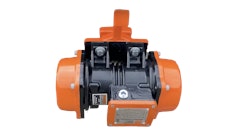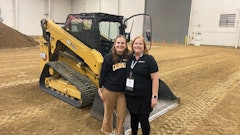
Due to more sophisticated asphalt mix designs, increasing quality expectations and ever-shrinking schedules, compaction requirements are more complex than ever. Compaction is one of the most important processes in roadway construction. It's necessary in order to attain high quality and uniformity of pavement materials, which in turn better ensure long-lasting performance. Intelligent compaction can help in this process.
Intelligent compaction (IC) might be the single biggest innovation in compaction rollers. Used currently on rollers 66 inches wide and larger, IC monitors the stiffness of the mat, the mat surface temperature, and the roller passes as it's compacted.
According to IntelligentCompaction.com, "Intelligent Compaction" (IC) refers to the compaction of road materials, such as soils, aggregate bases or asphalt pavement materials, using vibratory rollers equipped with an integrated measurement system, an onboard computer reporting system, Global Positioning System (GPS) based mapping, and optional feedback control.
"IC is an equipment-based technology for better quality control that results in longer pavement lives," says George Chang, PhD, PE with the Transtec Group. "IC machines are vibratory rollers with accelerometers mounted on the axle of drums, global positioning system, infra-red temperature sensors (for asphalt), and on-board computers that can display color-coded maps in real-time to track roller passes, asphalt surface temperatures, and stiffness of compacted materials. In short, intelligent compaction is a smarter way to get things done."
IC comes to Utah
The Federal Highway Administration (FHWA) has been leading a national effort to advance IC technology through various projects such as the Transportation Pooled Funded (TPF) IC project with 12 state DOTs from 2007 to 2011, and three National IC Workshops from 2011 to 2012.
The Utah Department of Transportation (UDOT) was interested to see how IC could help improve operations, reduce impacts to the public and deliver a higher-quality product, so UDOT contacted the FHWA’s Intelligent Compaction research team in February 2012 to express interest in participating in the national IC field study.
"UDOT was interested in the FHWA research on this technology and whether or not it would benefit our state," says Muriel Xochimitl, M.A. with UDOT, Region 3.
In February 2012, FHWA conducted an Intelligent Compaction National Workshop in Salt Lake City, UT.
The purpose of this workshop was to:
- Familiarize attendees with the fundamentals of intelligent compaction
- Demonstrate the route to successful IC implementation
- Spread awareness of the potential benefits of IC so attendees are more educated on the uses for their companies or organizations.
"Following the workshop, UDOT partnered with FHWA to host an IC demonstration in August 2012 after the technology was used on our US-89/SR-180 Pavement Rehabilitation Project," says Xochimitl.
The Federal Highway Administration (FHWA) has conducted 18 IC field projects so far, with eight or more scheduled over the next two years. Several state DOTs have also conducted IC projects, including MNDOT (at least five a year), INDOT, TxDOT, Vermont Agency of Transportation (VTrans), LA DOTD and MODOT. According to Chang, Transtec has also worked with 17 other contractors on projects in 13 other states.
Project particulars
The demonstration project was located at US-89 and SR-180 in American Fork and Lehi, UT. The total length of the project was approximately six center lane miles, with the target section for the study being approximately three lane miles.
The US-89/SR-189 Pavement Rehabilitation project was a mill-and-fill asphalt paving job for one lane in each direction. Four inches of the existing pavement was milled from the existing pavement. The new layers included a 2.5-inch-thick warm mix asphalt (WMA) base course and a 1.5-inch-thick SMA wearing course with a cross slope of 2%. The WMA was produced using the foaming method.
Staker & Parson was the contractor on the US-89/SR-189 Pavement Rehabilitation project, and they were the first company to use IC technology in Utah.
"Our organization was just introduced to IC thanks to this demonstration," says Jonas Staker, estimator and project manager with Staker Parson Companies. "Through this demonstration, the biggest benefit was learning about IC and what this new IC process and its long-term benefits can provide. It seems this might really help our industry."
Staker & Parson used two rollers on three paving shifts during the demo: a HAMM HD+120 double-drum IC roller and a Sakai SW880 double IC roller. The Sakai IC roller used a Trimble GPS system, while the HAMM IC roller used an OmniStar GPS system. A MOBA Pave-IR system was also used to help detect thermal segregation in the asphalt pavement in real time.
Coordinating a time that worked well for all the parties involved was the greatest challenge for the demo, says Staker. "Once we decided on a time, and all the parties arrived to the jobsite, the work went very well," he says. "The HAMM and Sakai rollers, along with their GPS equipment worked flawlessly. The MOBA system also worked well. This was all possible due to the time and effort of George Chang and his crew; they had every small detail planned."
UDOT also used IC for the first time on the US-89/SR-180 Pavement Rehabilitation project. "Because of the potential benefits of this technology, we are interested in looking into its use on future projects," says Xochimitl.
The benefits of IC
For both UDOT and Staker & Parson, there were many benefits to IC. "In the compaction process, IC technology continuously measures asphalt stiffness," explains Xochimitl. "Real-time data allows the project team to track and consistently compact the entire work area, which improves the overall quality of the asphalt on the roadway. The consistent pavement densities result in greater roadway smoothness and lower maintenance costs. Over time, the roadway’s higher quality will result in cost savings to the Department and the taxpaying public."
Staker also notes time and cost savings benefits when using IC. "Having real time feedback to the roller operator with compactions and densities is a huge benefit," he says. "With the GPS system mapping out rolling passes, the benefit of rolling the pavement (or aggregate) evenly will lead to pavements that will be compacted to optimum strength without being over or under compacted; these factors will increase the life of the pavement. From a cost perspective, having the roller measuring the stiffness of the pavement in real time could eliminate the cost of having a field technician on site, and/or possibly alleviate destructive testing."
Other benefits of IC include:
1. Improved quality of compaction operations
For asphalt pavement materials, compaction of the materials at the optimum time and temperature is critical. For soil materials, the IC rolling capabilities allow operators to identify non-uniform or weak areas for resolution before they become a problem.
2. Reduced agency maintenance costs
The increased quality control during construction results in longer lasting pavements, which will reduce agency costs.
3. Environmental sustainability
The improved rolling operations result in reduced carbon dioxide emissions.
4. Savings for contractors
By achieving 100% coverage at the required levels with no over- or under-rolling, IC technology maximizes roller productivity, ensures operations are done right the first time, and minimizes contractor pay reductions for not meeting agency requirements.
5. Safer operations
IC reduces the number of personnel needed to evaluate construction operations, minimizing exposure to work zone traffic.
"IC is a system that measures 100% of the road surface, instead of cores/nuclear gauge tests that only test a very, very small sample of the area," says Staker. "IC will lead to a smarter way of constructing a roadway, which will increase the life of the pavements. I think this technology is something we need to grasp as an industry."



























